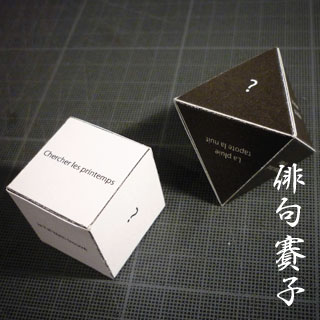HAIKU DICE
.jpg)
Project : Printemps des Poètes
2010.03.09 - 03.21
Jacques Kerchache Reading Room
musée du quai Branly, Paris, France
Curated by : Muriel Lardeau (FR)
A master piece which has been established by a certain cultural society will export to other cultural society. A toughened arrangement of words, "poem" is also not exception. Today we are able to read "Anthology" from far different culture translated into practical language. However, translated poem which probably disconnected from original, cultural and historical rhythms will generate unexpected effects sometimes.
I would now like to present Japanese traditional style of poetry, "Haiku", translating directly to French by using internet free translation service. A poem destructively construed by the machine will be cut off from the original landscape, while decomposing its emotion and vitality into a range of cold, dreary particles of word.
For instance, like the artistic subjects have been "enhanced" by analyzing fragment level of the color and the form during the abstract movement, will these technologically disarranged phrases be an experimental approach? What would these phrases that have been tossed into the "original" text box translate to?
Furuike ya / kawazu tobikomu / mizu no oto [1686: Matsuo Basho]
« Old pond frog and jump in the water Oto » [2010: http://www.google.com]
« old pond . . . a frog leaps in water's sound. » [2010: Wikipedia, the free encyclopedia]
.jpg)
* There is a word "pluie (rain)" in vertical line.
Project : Printemps des Poètes
2010.03.09 - 03.21
Jacques Kerchache Reading Room
musée du quai Branly, Paris, France
Curated by : Muriel Lardeau (FR)
In the process of learning other language, distinguishable words and indistinguishable words clearly separate depending on the literate degree. Imagination that roused by non native language are uncertain, and often evoke blague images that chaotically mixed up with other information.
At this process, only the words that he/she distinguish will stand out from the phrase (even if it is in fact wrong), by consisting plausibly at least for themselves, and lead the whole impression of the phrase. In other words, like children or foreigners, if the person is in an alien situation, unconsciously, his/her lacked information are boosted up by extended, unique imaginations.
It is hard to see something you don't know, and something you already know will inevitably be seen. There are always something you can see easily but not for me. Likewise easy for me but difficult for you.
I would now like to present a graphic that based on French text, which is quite fuzzy for me. By overlapping other image that I know, I would like to grope the depth of the imagination and the information.

Project : Printemps des Poètes
2010.03.09 - 03.21
Jacques Kerchache Reading Room
musée du quai Branly, Paris, France
Curated by : Muriel Lardeau (FR)
"Haiku, is a form of Japanese poetry, consisting of 17 moras* (or on), in three metrical phrases of 5, 7, and 5 moras respectively. Haiku typically contain a kigo, or seasonal reference, and a kireji or verbal caesura.
*Mora (plural moras or morae) is a unit of sound used in phonology that determines syllable weight (which in turn determines stress or timing) in some languages."
[From Wikipedia, the free encyclopedia]
The "HAIKU DICE" are dice that permit to create your haiku easily.
HOW TO PLAY HAIKU DICE?
1. Shoot the 6 faces die. The phrase will be the first verse. If you had the " ? ", you can create a 5 moras phrase freely.
2. Shoot the 8 faces die. The phrase will be the first verse. If you had the " ? ", you can create a 7 moras phrase freely.
3. Find the last verse. You can use 6 faces die again or create a 5 moras phrase freely. If you don't have "Kigo", the seasonal reference yet, adds a "Kigo".
4. The first phrase and the last phrase (both 5 moras) are replaceable. Adjusting preposition, conjunction, and article, please complete your Haiku.